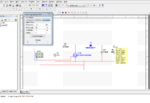- Joined
- Jan 22, 2008
- Messages
- 52,485
- Helped
- 14,756
- Reputation
- 29,794
- Reaction score
- 14,121
- Trophy points
- 1,393
- Location
- Bochum, Germany
- Activity points
- 298,363
The simulation shows boost operation. Which particular problem do you refer to?
Follow along with the video below to see how to install our site as a web app on your home screen.
Note: This feature may not be available in some browsers.
I see in the video that they vary as you change the gate drive voltage, not surprising. The gate voltage is probably too low, but I can't see this clearly from this toy style simulator results.It gives me variable input and output current. Are they should not be fixed?
@BradtheRad
Your circuit is working much good. You know, I tried your one and it is working well. But why not mine.
@BradtheRad
Your circuit is working much good. You know, I tried your one and it is working well. But why not mine.
Which simulator will you recommend me then?
We can find inductor value from the equation below,
L = [Vin(min) * D] / [fs * Irip]
where, L = inductor,
Vin(min) = minimum input voltage
D = Duty cycle
fs = switching frequency
Irip = Ripple current
If designer doesn't know Irip then he can't find inductor value, so he can use this equation. A good estimation of inductor ripple current is 20% to 40% of the output current, below
Irip = (0.2 to 0.4) * Iout(max) * Vout/Vin
OutputCapacitorSelection
Best practiceis to use low ESR capacitors to minimize the ripple on the output voltage. Ceramic
capacitors are a good choice if the dielectric material is X5R or better
the following equations can be used to adjust the output capacitor values for
a desired output voltage ripple:
\[Cout(min) =\frac{Iout(max) * D }{ fs * Vripp}\]
where,
Cout(min) = minimum output capacitance
Iout(max) = maximum output current of the application
D = duty cycle
fs = minimum switching frequency of the converter
Vrip = desired output voltage ripple
What should be Vrip so that I could calculate the Cout?
Is my value of L for the given parameters Correct. Huh??
And, how to know which capacitor has low ESR?
So please tell me how to know that how much vripp should be there for specific application or load. Means I have load a mobile battery. So how much Vrip should be beard by my circuit? you told 4%, why?
I don't have meter to measure ESR. So is there any way to find it out anyhow? Or at least you can tell me which capacitor is OK to use for my this Boost converter?
This statement helped me. I want to know if there is any note on voltage ripple or current ripple so that I could get more knowledge about them.It depends on what device you wish to power. Some devices require a tightly regulated power supply. Others do not.
Charging a battery does not need tight regulation. It can tolerate a large ripple voltage. However if you control the charge rate by means of voltage or current sensing, then you might wish to smooth the ripple to a smaller amount, say 1%.
Thank you for this detail explanation. I will ask you as I find something.ESR is not easy to measure, hence it is not commonly diagnosed.
The types which are most likely to develop ESR problems are aging electrolytics.
A new capacitor is likely to have low ESR.
In the event that you find either (a) the output ripple V is higher than expected, or (b) the capacitor is getting hot... You can substitute different capacitors of the same value, as a check.
For cheap methods of testing ESR, try an internet search on:
'99 cent ESR test adapter'
and
'capacitor ESR tester homebrew'
and
'barebones ESR tester'

View attachment 94453
Here is my designed boost converter....
What should I do to reduce the current but other parameters like Duty Cycle, output voltage should not be changed.
You said to reduce bias to the switching device. I didn't get. What do you mean by bias? Do you mean amplitude (which was 10Vp in the post#58)?
Thanks for your help sir.